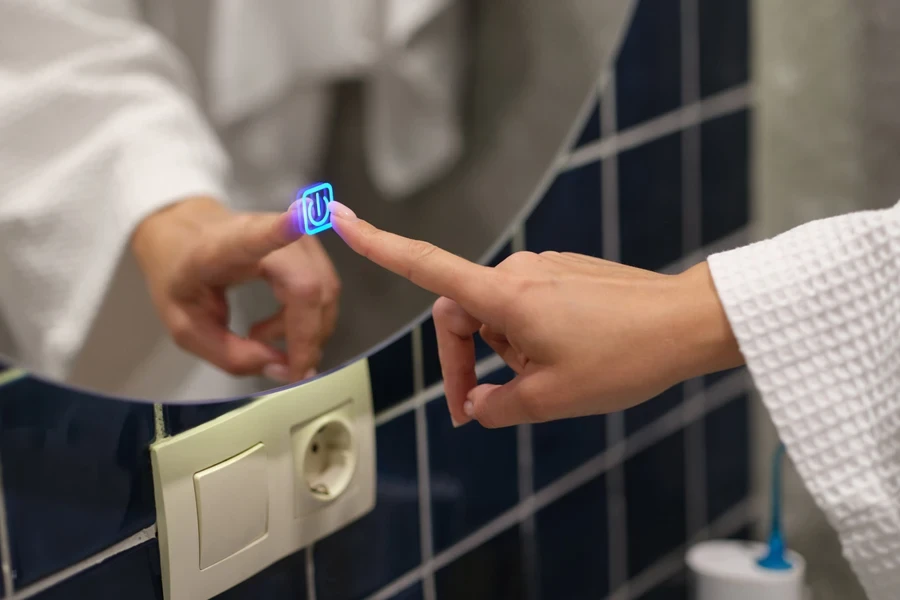Not long ago, the idea of a “smart mirror” might have sounded like something from a sci-fi movie. Yet the world is currently at a place where mirrors can display the weather, read schedules, and guide users through an at-home workout. And it’s a trend gaining a lot of attention (currently 90,500 searches in February 2025, according to Google).
Any retailer looking to capitalize on this trend has a huge opportunity, but it’s also important to distinguish the truly valuable features from the flashy extras. This article offers insights into the features customers care about most regarding digital mirrors—whether they want to enhance their morning routine or create a futuristic dressing room experience.
Table of Contents
9 features consumers look for in digital mirrors
1. Blending reflection with a good display
2. Looks still matter
3. Connectivity
4. Practical “smart” features
5. Privacy concerns and cameras
6. Durability and build quality
7. Setup and installation ease
8. Energy use
9. Target audience
Wrapping it all up
9 features consumers look for in digital mirrors
1. Blending reflection with a good display

The defining element of a digital mirror is that it is both a functional mirror and a digital interface. People still want to see themselves clearly, but they expect the mirror’s screen to show information crisply and fade into the background when not in use.
So, it’s no surprise that customers get excited about display quality, which usually boils down to resolution, brightness, and whether or not there’s a touchscreen. Some shoppers love the hands-on control of tapping the surface, even if it means wiping away fingerprints occasionally.
Others prefer using a voice assistant or a companion app so they don’t have to keep reaching across the glass. Both approaches can work, so it’s about stocking a variety that aligns with different preferences.
2. Looks still matter

Smart or otherwise, a mirror is inevitably a piece of home décor. That means aesthetics are still important. Sleek, frameless mirrors can suit minimalistic environments, while something with a decorative frame might fit better in a more traditional or upscale setting.
It’s also worth checking whether consumers can wall-mount a particular model or lean it against the wall. Some high-tech mirrors, specifically for bathrooms, come equipped with anti-fog technology, a big plus for customers who want to glance at the weather while brushing their teeth.
3. Connectivity
Because these mirrors are “smart,” they must connect to something. Hence, Wi-Fi is necessary if users want real-time weather updates, calendar syncs, or access to streaming content. Meanwhile, Bluetooth can connect external speakers or pair with a smartphone.
A mirror compatible with Alexa, Google Assistant, or Siri can be a major selling point, especially for people who already rely on voice commands throughout their homes. That being said, not everyone is equally tech-savvy. Some customers get frustrated if the setup process is too complex. Mirrors that walk them step-by-step through connecting to Wi-Fi or include a user-friendly app can cut down on returns and questions later on.
4. Practical “smart” features

The feature set is where many potential buyers decide if a digital mirror is worth the price. Some like seeing a small collection of widgets or icons: the current time, date, news headlines, and weather forecast. Others want a full-fledged experience, from streaming workout classes to checking social media feeds.
There’s also a growing interest in health features, such as mirrors that track posture during workouts or integrate with wearables to show heart rate in real time. Of course, more features sometimes mean a steeper price tag, so it’s useful to remember that not every buyer wants or needs the most advanced version.
5. Privacy concerns and cameras
The question of privacy will come up when you introduce cameras or microphones into a device that goes into someone’s home. Some high-end models use facial recognition to tailor the interface to each user. That’s neat, but it might raise eyebrows for people who worry about cameras in private spaces.
If retailers stock mirrors with built-in cameras, providing clear information on how the data is handled is a good idea. Are there encryption measures? Is there a physical shutter to cover the camera? These details can put potential buyers at ease—or at least let them know you’ve done your homework.
6. Durability and build quality

With electronic components inside a digital mirror, durability becomes even more of a concern. For this reason, retailers may have to convince users that their smart mirrors won’t fall apart in a bathroom. For starters, they should look for models that specify water resistance (especially if they’re intended for bathroom use) or highlight shatter-resistant glass.
A decent warranty can also set some brands apart, offering peace of mind to those on the fence about investing in newer technology. It helps if the mirror is easy to clean, too—after all, if it’s supposed to be a centerpiece of someone’s daily routine, it’ll need the occasional wipe-down to stay smudge-free.
7. Setup and installation ease
Not all smart mirrors are plug-and-play. Some might need professional installation, especially if the lighting system or unit size requires more complex electrical work. If consumers have smaller spaces, a mirror they can mount with minimal fuss might be more appealing.
Therefore, it’s a huge help when the manufacturer supplies a clear setup guide or video tutorial. From a retail standpoint, having that information on hand can help manage customer expectations and reduce dissatisfaction.
8. Energy use

Customers who want to stay green (or keep their electricity bill in check) might ask or worry about energy consumption. Some mirrors have an auto-dimming feature or a sleep mode that activates after inactivity. Retailers dealing with an especially energy-conscious crowd should look for models that mention power-saving capabilities or have an Energy Star rating.
9. Target audience
Finally, think about who the brand is selling to. If customers are mostly tech enthusiasts with a decent budget, they might gravitate toward premium units with advanced capabilities. If retailers cater more to families or first-time smart home users, a mid-range mirror with fewer bells and whistles might be the sweet spot.
Nevertheless, it’s good to showcase a small variety of price points. That way, someone can step up to a more feature-packed model if they’re excited by the possibilities—or keep it simple if they just want weather updates and a digital clock while they get ready in the morning.
Wrapping it all up
Smart mirrors may still feel futuristic, but they’re quickly becoming more mainstream. Offering a well-curated selection can set retailers apart from competitors who haven’t discovered them yet or aren’t ready to dive in. By focusing on display quality, aesthetics, connectivity, relevant smart features, privacy measures, and ease of installation, they’ll be equipped to guide their customers toward a product that truly fits their needs.
It’s also worth remembering that smart mirrors come in different shapes, sizes, and levels of complexity—so the “perfect” one depends on each buyer’s lifestyle and budget. If retailers can convey the value and practicality of each model they carry, they’ll be far more likely to close those sales and leave customers feeling they’ve found something cool and useful for their home.




